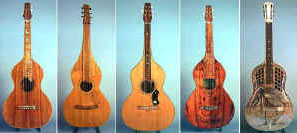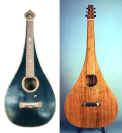|

|
Knutsen Hawaiian Guitar Variations
by Gregg Miner, as part of The Knutsen
Archives |

|
A comparison of all of Knutsen’s Hawaiian guitars could well serve as
someone’s Thesis.
I’m merely showing some obvious points below.
If one were to examine Knutsen’s "Weissenborn-shaped" Hawaiians,
they’d first have to compare the Convertibles, Hollownecks, and Harp
Hawaiians. Then - within each of these categories, no two are exactly alike –
with minor or major differences in:
- Headstock shape
- Bridge shape
- Body dimensions
- Transition point of neck (hollow to solid)
- Wood combinations
- Binding, trim and inlay
- Scale length
- Frets (flush or raised)
- Nut (low or high, slanted or not)
- Braces
- Label
One way to compare the instruments is via the main thumbnail galleries.
Another is to scroll down the Inventory spreadsheet. Either will offer a
fascinating variety of features, from subtle to striking.
 |
This first row illustrates both the similarity and the
differences between:
- A Knutsen convertible
- Two random Knutsen hollownecks
- A Weissenborn
- A National squareneck
click image to enlarge
(images copyright Gregg Miner, from the collection of Jonathan
Kellerman)
|
 |
A look at Knutsen’s teardrop style compared to
Weissenborn’s teardrop style.
click image to enlarge
(images copyright Gregg Miner. Weissenborn from the
collection of Jonathan Kellerman)
|
 |
Hawaiian guitar bridges:
These are not in any specific order, and are only roughly to scale.
Represented are:
- Knutsen HCW1
- Knutsen HCW2
- Knutsen HCW4
- Knutsen HW6
- Knutsen HHW13
- Knutsen HW7
- Knutsen HTD1
- Knutsen HW13
- Kona ca. 1912-1915
- Early Weissenborn
- Mid period Weissenborn
- Late Teardrop Weissenborn
- Shireson Lyric ca. 1918
- Hilo ca. 1920s
click image to enlarge
(images copyright Tom Noe and Gregg Miner) |
 |
 |
Like his harp ukes, Knutsen’s "Upper Treble Point" Harp Hawaiians,
show a huge variety of one-of-a-kind hand-crafted headstocks and harp arms (left
image).
His pointed flares (right image) fall into two main types: a simple silhouette
(left column), and the protruding, carved extension (center column). A third
variation, seen once, is an even sharper point, with a non-carved extension
(right column).
Examining the Inventory sheet, one again sees every possible combination of
woods and trim, plus various stringing combinations (3-4 bass strings, 0,3,4 or
5 trebles along with the 6 standard neck strings).
click image to enlarge
(images copyright Gregg Miner)
|
If you enjoyed this article, or found it useful
for research, please consider supporting
Harpguitars.net so that this information will be available for
others like you and to future generations. Thanks!
|
[Biographical]
[Instruments]
[Historical
Photos]
[Credits]
[FAQ]
[Bibliography]
[Updates]
[Links]
[Contact]
[Home
(Knutsen Archives)] [Home
(Harpguitars.net)]
All Site Contents Copyright © Gregg
Miner, 2002, 2003, 2004, 2005,2006,2007,2008,2009. All Rights
Reserved.
Copyright and Fair Use of material and use of images: See Copyright
and Fair Use policy.
